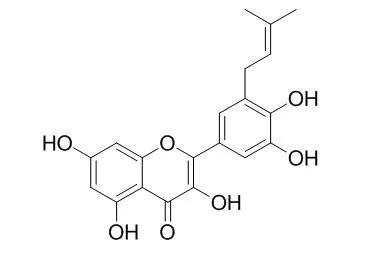| In vitro: |
| Food Chemistry, 2008, 106(2):529-535. | | Tyrosinase inhibitors from paper mulberry (Broussonetia papyrifera)[Reference: WebLink] |
METHODS AND RESULTS:
Fractionation of a chloroform-soluble extract from twigs of Broussonetia papyrifera, led to the isolation of one new compound, 3,5,7,4′-tetrahydroxy-3′-(2-hydroxy-3-methylbut-3-enyl)flavone (1), and 10 known compounds, Uralenol (2), quercetin (3), isolicoflavonol (4), papyriflavonol A (5), broussoflavonol F (6), 5,7,3′,5′-tetrahydroxyflavanone (7), luteolin (8), isoliquiritigenin (9), broussochalcone A (10) and 5,7,3′,4′-tetrahydroxy-3-methoxyflavone (11). Their structures were identified by interpretation of MS, 1H NMR, 13C NMR, HMQC and HMBC data.
CONCLUSIONS:
Their inhibitory activities on mushroom tyrosinase using l-tyrosine as substrate were investigated and the IC50 values of 3,5,7,4′-tetrahydroxy-3′-(2-hydroxy-3-methylbut-3-enyl)flavone, Uralenol, quercetin and broussoflavonol F were found to be 96.6, 49.5, 57.8, and 82.3 μM, respectively, better than arbutin, a well-known tyrosinase inhibitor. | | Phytochemistry Letters, 2013, 6(3):331-336. | | Prenylflavone derivatives from Broussonetia papyrifera, inhibit the growth of breast cancer cells in vitro and in vivo[Reference: WebLink] | Two new prenylflavones 5,7,3′,4′-tetrahydroxy-3-methoxy-8-geranylflavone (1) and 5,7,3′,4′-tetrahydroxy-3-methoxy-8,5′-diprenylflavone (2), as well as four known ones, Uralenol (3), papyriflavonol A (4), broussoflavonol B (5) and broussochalcone A (6) were isolated and purified from an ethyl acetate-soluble extract of the barks of Broussonetia papyrifera.
METHODS AND RESULTS:
Their structures were determined with the spectroscopic methods including HR-EI-MS, 1D and 2D NMR. We found that compounds 2–6 showed potent anti-proliferation effects on ER-positive breast cancer MCF-7 cells in vitro. The IC50 values of compounds 2 and 5 were 4.41 and 4.19 μM respectively after the treatment of 72 h. We also found that compounds 2 and 5 strongly down-regulated expression concentrations of estrogen receptor-α (ER-α) and were able to inhibit tumor growth in a xenograft model of the human breast cancer line BCAP-37 in vivo.
CONCLUSIONS:
Our results demonstrated that prenylflavones from B. Papyrifera exhibit potent anti-tumor activity. |
|






 Cell. 2018 Jan 11;172(1-2):249-261.e12. doi: 10.1016/j.cell.2017.12.019.IF=36.216(2019)
Cell. 2018 Jan 11;172(1-2):249-261.e12. doi: 10.1016/j.cell.2017.12.019.IF=36.216(2019) Cell Metab. 2020 Mar 3;31(3):534-548.e5. doi: 10.1016/j.cmet.2020.01.002.IF=22.415(2019)
Cell Metab. 2020 Mar 3;31(3):534-548.e5. doi: 10.1016/j.cmet.2020.01.002.IF=22.415(2019) Mol Cell. 2017 Nov 16;68(4):673-685.e6. doi: 10.1016/j.molcel.2017.10.022.IF=14.548(2019)
Mol Cell. 2017 Nov 16;68(4):673-685.e6. doi: 10.1016/j.molcel.2017.10.022.IF=14.548(2019)